Posts Tagged ‘common core state standards’
Tangrams: A Cross Curricular, Experiential Unit
Now that I am back in the classroom two days a week teaching gifted elementary students, I can do and report on the cross curricular units I plan and implement. There are several guiding factors that I use to design my units:
- They need to be hands-on and experiential.
- Learner choice and voice is valued.
- They need to address cross curricular standards. It is like life. Life doesn’t segment content areas into separate entities.
- They do not depend on the use of worksheets. Worksheets tend to address a single standard or skill. Plus, learning how to do worksheets is NOT a life skill.
- Communication, collaboration, and problem solving are built into the learning process.
- Reading and writing are integrated into the learning activities in the form of fun, interesting books and stories, and writing stories, narratives, journalistic reports.
- Educational technology is incorporated but with a focus on using it to interact with real world physical objects and people.
- A reflective component is included.
- The educator becomes a facilitator whereby activities are introduced and then the learners become the active agents of their own learning.
- The goal is to create the conditions for learners to say they the best day ever.
Tangrams: Cross Curricular Unit
The tangram (Chinese: 七巧板; pinyin: qīqiǎobǎn; literally: “seven boards of skill”) is a dissection puzzle consisting of seven flat shapes, called tans, which are put together to form shapes. The objective of the puzzle is to form a specific shape (given only an outline or silhouette) using all seven pieces, which may not overlap. It is reputed to have been invented in China during the Song Dynasty,[1] and then carried over to Europe by trading ships in the early 19th century. . It is one of the most popular dissection puzzles in the world. (https://en.wikipedia.org/wiki/Tangram)
Goals:
The students will be able to:
- Read and comprehend literature, including stories, dramas, and poetry, in the grades 4-5 text complexity band proficiently. (CCSS.ELA)
- Write narratives to develop real or imagined experiences or events using effective technique, descriptive details, and clear event sequences. (CCSS.ELA)
- Classify two-dimensional figures based on the presence or absence of parallel or perpendicular lines, or the presence or absence of angles of a specified size. Recognize right triangles as a category, and identify right triangles. (CCSS.MATH)
- Understand that shapes in different categories (e.g., rhombuses, rectangles, and others) may share attributes (e.g., having four sides), and that the shared attributes can define a larger category (e.g., quadrilaterals). Recognize rhombuses, rectangles, and squares as examples of quadrilaterals, and draw examples of quadrilaterals that do not belong to any of these subcategories. (CCSS.MATH)
- Develop and portray characters including specifics about circumstances, plot, and thematic intent, demonstrating logical story sequence and informed character choices. (ELA and Visual Arts)
- Demonstrate ability to work effectively and respectfully with diverse teams. (21st Century Skills)
- Assume shared responsibility for collaborative work, and value the individual contributions made by each team member. (21st Century Skills)
- Solve different kinds of non-familiar problems in both conventional and innovative ways. (21st Century Skills)
Materials:
- Tangrams (can be made or bought – I have purchased several sizes and types over the years)
- Grandfather Tangram book (or via Youtube https://www.youtube.com/watch?v=x74l1ZM-zP0)
- Pictures of Tangram animals from Grandfather Tangram – a set for each student. I like the use of a set of cards so learners can’t see the next animal until they are asked to turn over the card when that animal appears in the story (or a projected via http://exchange.smarttech.com/details.html?id=9bfd751c-ca5d-4733-9748-475963892d53)
- Handout of Tangram shapes
- Large Set of Tangrams made out of 48″ x 48″ sheet of plywood (directions for how to make similar ones out of cardboard can be found at https://www.bloglovin.com/blogs/oh-happy-day-2622736/diy-giant-tangram-4939798307)
- Tangoes – a set per each pair of students (only higher price item for this unit)
- Templates for 3D Tangrams – found at http://www.tangram-channel.com/3d-tangrams-templates/
- Scissors, glue sticks, tape
- Chromebooks or iPads
Learning Activities
Read Grandfather Tangrams + Learners Create Tangrams for Each Story Character

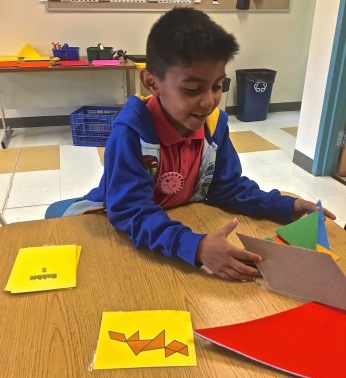
Each learner is given a set of tangram puzzle pieces and a set of cards that shows how to make each tangram animal in the story. Grandfather Tang is read to the learners either directly from the book or through https://www.youtube.com/watch?v=x74l1ZM-zP0 so it can be projected. The story is stopped each time there is a reference to one of the Tangram animals. Learners construct that animal using their own set of Tangrams.
Check-In with Tangrams
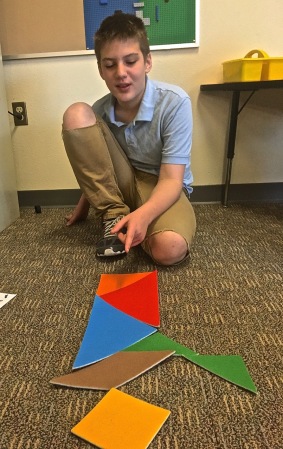

One of my morning activities with learners is to have them check in as to how they are doing that day. The check in for this unit is to create a Tangram that represents how they are feeling. Selections are made from a sheet given to learners:

Giant Puzzling Tangrams
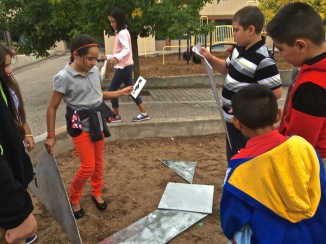
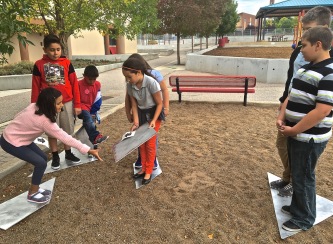
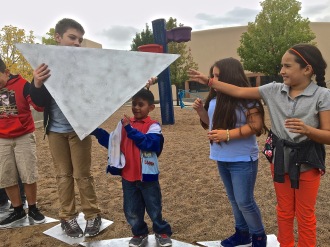
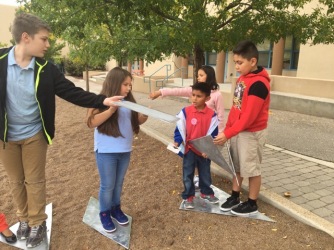
Making the props for this activity is worth the trouble as it is a very high engagement, high learning, high reward activity. To set it up, an area is chosen that is about 50 yards long (outside or in a gym) and the giant Tangram shapes are placed in a pile at the start of this area. Learners are given a card that has the design of a Tangram at the beginning of this area. They need to produce that Tangram and then all get on top of that shape. Their goal then becomes to cross the designated area using the Tangram pieces as stepping stones. If they fall off, they must go back to the beginning and start again. When they reach the end of the designated area, they are given another Tangram shape they need to construct prior to stepping off. This translates into the need for them to maneuver the Tangram pieces into the design while standing on pieces.
Tangoes Tangram Card Game – Paired Challenge
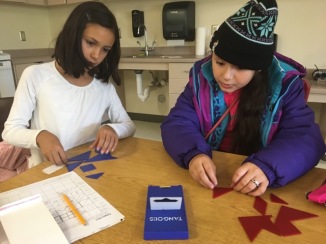
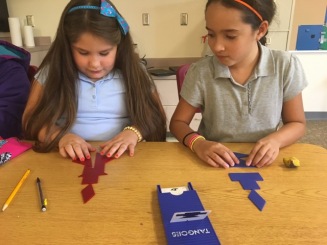
Next, the learners play the Tangoes card game in pairs. The object of Tangoes is to form the image on the card using all seven puzzle in a challenge with another learner in a race to solve the puzzle. It helps build visual spatial skills as the cards don’t have demarcations for the individual Tangrams. I promote some cooperative work as I ask the partner who figured out the answer to help his or her partner to do so, too.
Make 3D Tangrams
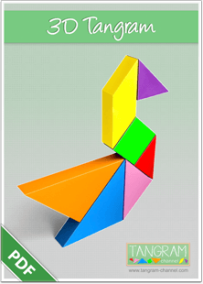
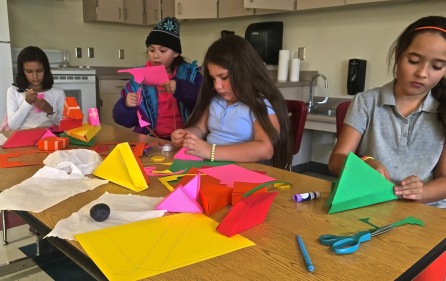
Learners are given the printed out templates for a set of 3D Tangrams and construct them.
Create a Story from 3D Tangrams – Take Photos and Write a Blog Post

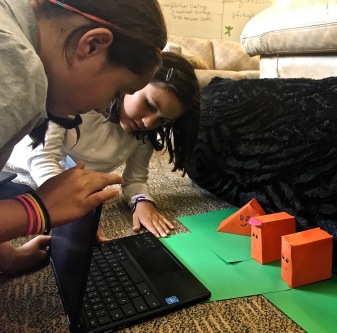
Learners think of a story using their 3D Tangrams and take photos for the scene(s) of their stories. They then upload these images to their blogs and write about their story.
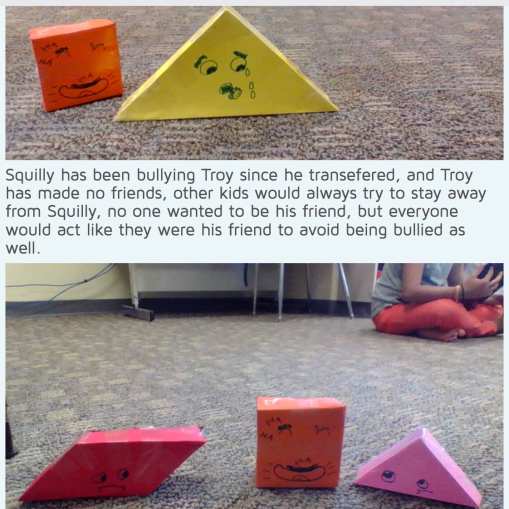

(Postscript: Wow – I didn’t review their blog posts until after school. We are definitely going to discuss this student’s blog post during on next class session. Great teachable moment to discuss this real life situation of one of their classmates.)
Written by Jackie Gerstein, Ed.D.
September 10, 2016 at 6:25 pm
